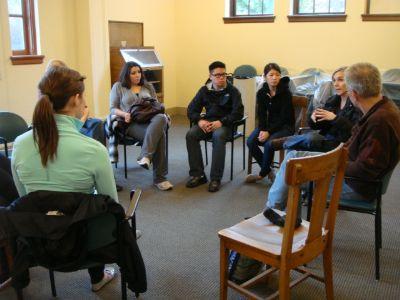
During the tour, students learned about the transformation of the cacao fruit into chocolate. The tour highlighted the important role that cocoa farmers play along with the social and environmental issues in the chocolate industry, especially the issue of fair trade.
Ivy Fox, a tour guide at Theo, explained that because 70 percent of the world’s chocolates come from Ghana and the Ivory Coast, it is important for consumers to understand where their food is coming from and the conditions in which farmers prepare and produce food.
“We are really proud of the fact that we are the only fair trade chocolate company in the country and we are the only fair trade organic makers,” said Fox.“Throughout the years, we’ve been disconnected from our food and even if it’s not fair trade, it’s important to know where our food comes from.”
While students sampled chocolates from Madagascar, the Dominican Republic and Costa Rica, Fox explained the importance of working with growers to ensure that they earn a living wage and have access to education for their families. Fox also reviewed the meaning of fair trade, the fair trade logos and the health benefits of chocolates.
Last fall, Professor Angelina Godoy taught an LSJ special topics class on “Human Rights and the Market,” where students looked at how the market can sometimes further and sometimes frustrate human rights. The students were challenged to analyze the strengths and weaknesses of using the market to advance human rights.
During the class, one group of students examined the viability of fair trade clothing at the University Book Store. The other focused on Theo, where they sought to create a standard to use in determining a fair price for cacao in all of the countries that supply the company.
After the tour of Theo, the group met to discuss the meaning of fair trade and the human rights connections with this idea. Godoy explained that in fair trade as a whole, there is a tension between companies that are committed to 100 percent fair trade and the big companies like Starbucks and Walmart that are only committed to ensuring that a small percentage of their products are fair trade certified.
“There’s clear evidence that if these [big companies] join, the standards get watered down,” said Godoy.
The group also discussed the differences between the two recognizable fair trade logos, Fair Trade USA, the only independent fair trade certifier in the United States and IMO “Fair for Life,” a third party certification programme for Social Accountability and Fairtrade.
“There isn’t a universal consensus [among companies]…the question is fair trade according to who?” said Godoy.
Both Fair Trade USA and IMO “Fair for Life,” have different standards of what constitutes a fair trade product. Godoy explained that the standards not only vary from one system to the next but even within each system. For example, what is required to designate a mango “fair trade” is very different than what is required to certify coffee or cocoa.
Riley Bundy, a senior LSJ major who helped to organize the event, said it was a huge success and that it was interesting to hear the students’ insights on fair trade.
“It was great to see the theories in the classroom brought to an actual company whose business practices influences real life around the world,” said Bundy.
This article was composed by Charlotte Anthony.